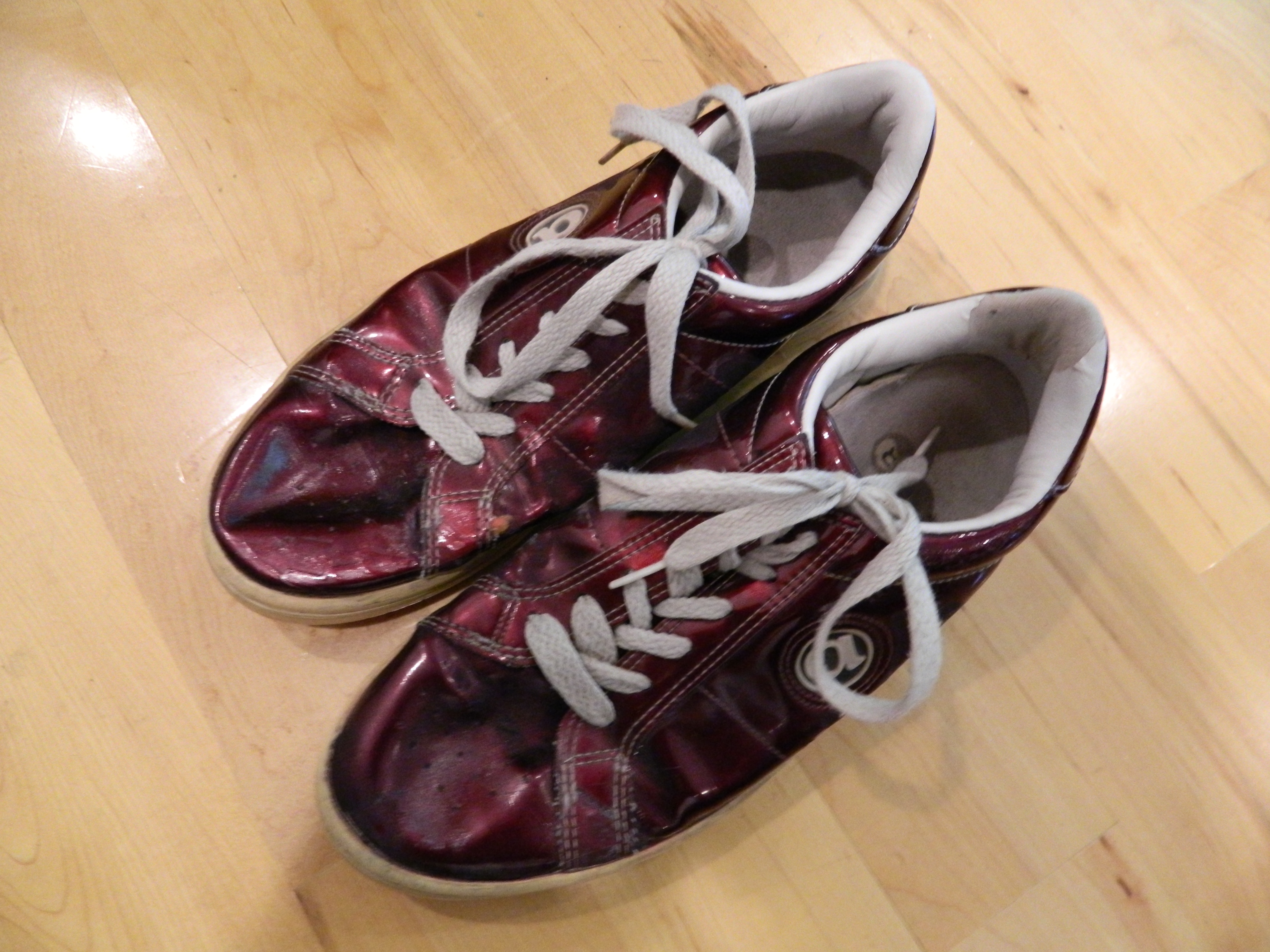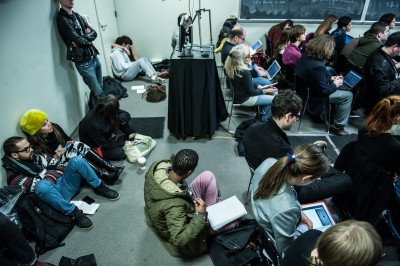
Ever since it and I first became acquainted, I have been the sort of person who goes by strange made-up names on the Internet. That “ever since” is a long one, too: It begins in the fall of 1995, when my classmates and I returned to school to find not only that the dark room full of DOS machines had been swapped out for a bright room full of Windows boxes with Internet access, but also that we now had email accounts—something most of us didn’t have at home.
To our mostly pre-digital teenaged selves, email was clearly the Best. Thing. Ever.
My friends and I spent all of our free periods in the computer lab emailing each other, even though we went to a small school and so all saw each other every single weekday. We passed silly forwards around (like “100 Things to Do in An Elevator”), and had group conversations, and had long one-on-one conversations as well—often conversations that, for a whole range of reasons, would never have happened through in-person interaction. I spent some of the most intense, exciting hours of that school year in the computer lab, engaged with those machines (and through them, my friends) as if they were lifelines.
I’m reasonably certain our usernames on those email accounts were assigned by the school, and so probably had something to do with our legal names—but that’s not what I remember. What I do remember is that, within a few weeks, we all started signing our emails to each other with what I’d later recognize as “handles,” most of which were based on nicknames we had amongst each other. I signed all of my messages “rubyslippers,” for instance, after my friends’ name for the (fabulous) red metallic Airwalks I wore on a daily basis (see above).
Then summer came, and horror of horrors: I was facing almost three months without the Internet. Salvation came via snailmail, however, in the form of one of those “10 hours free!” AOL CDs—and in parents indulgent enough to install two new phone lines (I suspect the only thing worse than listening to my younger brother and I fight over the existing phone line was trying to get either of us off of it to make an actual phone call). Miracle of miracles, I could breathe again: by late June, the Internet and I were reunited.
I still remember that summer night vividly. I had a hand-me-down Intel 386 from my brother sitting on one end of the old coffee table in my room (my stereo—including a receiver older than I was—got the other end); I had myself sitting awkwardly on a stepstool in front of it, because there were only two feet of space between the coffee table and my bed. Giddy with anticipation, I sat wide-eyed and perched more or less like a gremlin through the entire installation process, until finally the magic moment arrived: picking my new AOL username. But “rubyslippers” was taken, and so was just about every possible alternate spelling, up to and including even “rubyshoes.” It took an hour of thinking and trying different possibilities, but finally I had it: I became “Al2O3shoes” on the Internet, because that’s just the kind of dork I am.
(If you don’t get the joke, “Al2O3” is the chemical formula for corundum, which in its red gem form is called “ruby.” Yup.)

I was Al2O3shoes until I went off to college, at which point I got a new username for my university account. My school was nice enough to let us choose our usernames (though there was an eight character maximum), and for months I’d been planning on using my initials—my best friend from high school was a year ahead of me at the same university and had used his initials for his username, and his resultant email address had a certain elegant simplicity that I found appealing. Yet when the time came, there I was—this time stumped on a summer afternoon in the W20 cluster, because some guy named David already had my initials as his username. Why did he get to be web@mit.edu?
Oh. Right. Ha-ha.
And so there, by virtue of what someone nicknamed the Internet, went my one brush with almost going by something related to my legal name online. The made up word I did come up with for a username remained my only name online for more than a decade, and to this day remains the name my “personal” identity uses online. Perhaps it is unsurprising then that, when I did begin a new “public” Internet presence in early 2011 by starting a second (open) Twitter account for conference-going, it never occurred to me to use a username based on my legal name. Instead I chose another made-up word: “phenatypical,” which—as a portmanteau of “phenotype” and “atypical”—seemed appropriate for someone who was (at the time) researching personal genomics and had unnaturally bright hair. (Again, that’s just the kind of dork I am.)
In summary, there you have it: I am, and have from the beginning been, the kind of person who goes by dorky, esoteric made-up names on the Internet, and I have repeatedly resisted pressure from a variety of online platforms to do otherwise. My personal email account (which is by far my oldest gmail account) quit Google+ over nymwars in the summer of 2011; I stopped using Facebook for two years in part over their “real names” policy (also in part over that glaring spring 2010 privacy snafu). I am a firm believer that my name is me, and in some ways, my suite of strange pseudonyms is more “me” than my legal name will ever be.
Yet despite all this, for almost a year now, I’ve been doing some serious soul-searching about whether I should change the username on my public Twitter account to something based on my legal name. For a change that’s really pretty trivial, the matter has also turned out to be a really big deal to me—and trying to muddle my way through the decision has made me realize just how much my sense of identity and self-conceptualization really are tied up in a name. My strongest, most readily apparent feeling is that I don’t really want to change my username at all—yet at the same time, I can’t shake the nagging feeling that I’m missing out both on professional cultural capital and on opportunities to increase my name recognition. And as the nagging anxiety about not changing my username mounts, and I continue to confront and dissect my deep ambivalence about changing, I’m realizing there’s part of me that does want to change my username as well.
It started at ASA 2012, as Nathan (@nathanjurgenson) and PJ (@pjrey) and I were all sitting in the audience at the same panel session, and so doing what we tend to do when that happens: engage in rapid-fire debate and discussion on the conference hashtag. Watching my columns scroll in TweetDeck, I suddenly realized that with every retweet, every mention, and every reply, they were both increasing the general (tweeting) public’s familiarity with their names, whereas people would have to glance down at my conference badge in order to connect me, my legal name, and my Twitter handle. I wondered if I shouldn’t think about switching, but in the middle of a conference seemed the worst time to do so; changing also didn’t feel quite right. At the time I’d just joined Cyborgology as a regular contributor, and I took comfort in the fact that, while all the men writing for Cyborgology had legal-name-based usernames, none of the women then-writing did; I could also point to some prominent women whose work I admired who were using pseudonyms on Twitter as well.

ASA 2013 is now around two weeks away, and my one-year anniversary as a Cyborgology contributor is two days away…and I’m realizing that a lot has changed over the last year. Jenny Davis is now @Jenny_L_Davis, and Zeynep Tufekci is now @zeynep; it genuinely gives me hope for the world that danah boyd is still @zephoria, but as every grad student who loves studying the Internet gets told a million times, “we don’t all get to grow up to be danah.” I’m also realizing that, entirely despite myself, my instinctual reaction is to take new Twitter followers more seriously if their username seems based on a legal name; somehow it seems that’s what most of the people who are serious about being Public seem to be doing these days. And as I continue to work at building a public self, it more and more seems as though I should follow their lead (and save everyone who tweets at me four characters) by dropping down to my first two initials and my last name: @weboesel.
And yet, it’s neither quite that simple nor that easy. In a weird way, the idea of changing my username feels like “having to grow up”—not because there’s anything child-like about using a pseudonym, but because changing my username feels like a scary and increasingly inevitable shift in my identity. My pseudonym is in many ways more “me” than my legal name, and yet the idea of using my legal name scares me because it feels too much me. The idea of going first & foremost by my legal name—something I’ve never really done on the Internet, save what’s now my oft-neglected professional Facebook profile—feels frighteningly naked, so intensely visible. I’d just be myself, plain and in plain sight, right there in front of everyone.
On a visceral level, I find the idea of that kind of visibility to be completely terrifying—and yet, it’s the fact of that terror that has finally tipped the scales toward making the change. I see it in some ways as a small, personally political statement about women and visibility: if on some level I fear being visible (and I do), then I will walk straight into my fear and become more visible. It’s also that, if I’m really going to do this public academia thing, if I want to become a public figure, if I want a public life—and I do, all of it—then I have to take the deep breath and let go and become those things, release that public part of me to become. While obviously there remain successful women public intellectuals whose usernames have nothing to do with their legal names, I’m starting to realize the “becomingness” piece is what changing my username symbolizes for me. Ever since I discovered Academic Twitter™ following #TtW12, a public self has been in formation; as she continues to become, I increasingly feel that she’s constrained by an older identity and an older name.
Again, so much has changed since #TtW12: how I use Twitter; what I believe to be possible—& therefore, what I desire—professionally, academically, and intellectually; what I want and believe to be possible in life itself; the mundane realities of my day-to-day existence; everything in between all of those things. As a sociologist, I’m on board with the fact that identity is neither stable nor a linear narrative, and yet more so than in most other years, I feel like I left 2012 markedly different from the person I was when I went in. And I think this, too, is part of the tension: The fact that I’m somewhere in the middle of becoming a person who, in her array of selves (some more familiar, some less), also has a capital-P Public self. That newer, public self seems to need—and also, to want—to take up more visual and textual space, instead of lurking inside an esoteric demonstration of my cleverness until she feels like stepping out.
And so, in the end—after months of borderline-neurotic deliberation—I’ve come to the conclusion that I do need to change my username. I just wish anyone had given me an unequivocal “you must change” argument along the way, so that I might feel less unsettled as I do so.
Releasing old selves is hard.
Whitney Erin Boesel was @phenatypical on Twitter from March 2011 to July 2013; as this post goes live, she’s initializing the change to @weboesel.

Comments 11
Letta Page — July 24, 2013
I just have to say: I had those exact sneakers. This makes me feel very happy. Now I'll read the article.
Egg Syntax — July 25, 2013
Hey, thanks so much for this great post. I've struggled with this same issue for years, and haven't yet chosen to change the name I've always gone by online, which is completely unrelated to my legal name, but you've provided a lot of great food for thought here.
Angela Chen — July 26, 2013
I definitely empathize with the sense of identity that become attached to certain usernames. I'm quite a bit younger than Whitney, and so had my first AOL (Messenger) username around 2002. It was, well, my first and last name and the dates of my birthday, completely flouting all advice about how teenagers should be safe on the Internet. I promptly abandoned it though when it became obvious that having interesting or "cool" usernames were a form of social capital -- I even remember how people would have both, and AOL Messenger had a way to link them so you could use both simultaneously.
Since then, I've agonized over emails, usernames, my Twitter handle, but I'm not as attached to any of these usernames as I am to my OkCupid username. Though we all know the username is not as important as the photos, the gravity of the OKC username is generally greater than that of other types of handles, and can signify a variety of things. For example, I have never gone on an OKC-mediated date with anyone who had numbers in their handle -- this wasn't a conscious choice, but it turns out the type of people I like tend to put more time into picking a unique username and not adding numbers to the end of one already taken.
On (not) growing up on Twitter » Cyborgology — August 23, 2013
[...] particular piece of navel-gazing was inspired by a wonderful post that Whitney Erin Boesel wrote a while ago on changing her Twitter username to reflect a greater owning of what she feels is her professional [...]
The Introvert Fetish » Cyborgology — August 30, 2013
[...] [i] Yes, pencil and paper: I’m probably among the youngest of people who encountered the Myers-Briggs Type Indicator (or something a lot like it) before they encountered the Internet. [...]
Sextual Healing » Cyborgology — September 4, 2013
[...] on paper but wrote poetry on computers (also napkins); I wrote letter-length notes during class but sent email during my free periods; in general, I communicated with friends and family (as well as myself) through an array of both [...]
The Spotification Diaries » Cyborgology — September 21, 2013
[...] with a series of much larger changes over the past year, changes that have occurred as I’ve started to assume more of a public life. Slowly but surely, I’m acclimating not only to the process of becoming more visible generally, [...]
Resistance + Appropriation, + More Appropriation » Cyborgology — October 24, 2013
[…] love when conferences do that (even if I had to edit mine, because I registered for #ir14 before I changed my Twitter username). The second was that there was a sticker on it, a little cartoon fish. “What’s the sticker […]
Cyborgology Turns Three » Cyborgology — October 26, 2013
[…] and honored by the number of people who have come up to me at conferences to talk about “What’s In A (User)Name?” (a post which meant a lot to me personally, but which I’d thought was basically […]
Identity on the Internet | This is important. — March 10, 2014
[…] to the things we care about, our nicknames, and eventually, some variation on our actual names. Whitney Erin Boesel describes this transition well in Cyborgology, concluding with her decision to change her username on Twitter to a variation on her name. […]